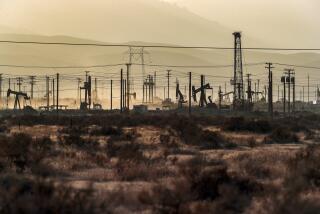Plan for Nuclear Dump Stirs Rancor in Rural Nebraska
- Share via
SPENCER, Neb. — In a back-roads town where being a good neighbor is as important as church on Sunday, the prospect of a nuclear waste dump has spawned an economic boycott and discordant civic meetings. It’s pitted friend against friend.
In January, Boyd County, a sparsely populated agricultural area on the South Dakota border, became one of three semifinalist sites for a low-level radioactive waste dump in Nebraska.
“It’s the most tragic thing that’s ever happened here,” said Lowell Fisher, a third-generation rancher who is chairman of the Save Boyd County Assn.
Don’t Want ‘Garbage’
“We’re not anti-nuke kooks, we’re not a bunch of political activists, we’re babes in the woods when it comes to trying to stop this. But we live in God’s country, and we don’t want everybody else’s garbage.”
Fisher’s group has gathered 1,107 signatures from persons opposing the dump. About 3,000 people live in Boyd County, and 1,499 voted in the last general election.
But J. C. Marcum, a retired Spencer veterinarian who heads People for Progress in Boyd County, is delighted that the dump might be located within 12 miles of his home.
“Outside rabble-rousers have teamed up with local kooks to coerce people into being against the waste site,” Marcum said. “These farmers don’t read very much, they aren’t educated on the issue. They think their property values will be lower, but, in fact, they’ll be higher, and we may get as many as 40 new jobs out of it.”
He criticized the dump opponents for boycotting businesses owned by supporters. “People I’ve known for 35 years won’t speak to me, but that doesn’t bother me. I’ve got a thick hide.”
About $2 million will be spent this year to study surface and ground water, geology, topography and environmental resources of 320 acres in Boyd County, along with similar acreage in two other semifinalist counties: Nuckolls on the Nebraska-Kansas border and Nemaha on the Nebraska-Iowa line near the Missouri River.
The dump is designed to be an above-ground reinforced concrete vault capable of storing 5 million cubic feet of waste. Its life span will be 30 years or full capacity, whichever comes first. Radioactive refuse will be trucked in from five states.
The semifinalist sites were picked in January after a months-long winnowing process. Eighty communities at first expressed interest in the dump’s potential jobs and fees--an estimated $40 million over three decades for local and state governments--but eventually almost all decided: Not in my back yard.
A dead black cat in his mailbox caused a Webster County commissioner to switch his vote from favoring to opposing the site in his county. Letters to the editor got bitter and personal.
“As long as our governor (Kay A. Orr) and state oppose the right of the people to vote on the waste site being placed in their county,” Fisher wrote, “strife will only increase.”
Federal law mandates that every state have a dump for its low-level radioactive garbage--mostly tools, clothing and resin from nuclear power plants--by Jan. 1, 1993. Most states are banding with others in regional disposal compacts.
Nebraska voted against being the site of the Central Interstate Compact dump but was outvoted by Kansas, Oklahoma, Arkansas and Louisiana, who argued that Nebraska ranked highest in generated waste and environmental suitability.
Utilities Fought Initiative
A referendum issue that could have made Nebraska the first state to pull out of a compact was defeated by a nearly 2-1 ratio last November. The citizens’ group that placed the issue on the ballot raised only about $25,000 to get its message across, compared to the $1.5 million spent by the utility industry to defeat the measure.
Political analysts believe ads warning that power plants could be shut down and hospitals might cut back radiological treatments if the initiative were approved had led many ambivalent residents to vote to retain the compact.
When Initiative 402 was rejected, US Ecology Inc., the company chosen in 1987 by the compact to find a site and build and operate the dump, forged ahead. The Louisville, Ky.-based firm disposed of nearly half the nation’s commercial low-level radioactive waste in 1987.
But US Ecology’s track record is a major cause of concern to Nebraska’s dump opponents because two of its now-closed low-level radioactive waste sites leak.
Vice President Richard Paton vows that US Ecology is committed to building a state-of-the-art dump in Nebraska on a site that will meet or exceed public health and safety requirements.
‘Can’t Predict Future’
“No one can make guarantees about the future,” said a US Ecology handbook distributed to Nebraskans, “but, through the judicious selection of a site that meets or exceeds the siting standards, and the concept of multiple engineered barriers built into our design, the situations that occurred at below-ground disposal facilities built in the 1960s are very unlikely to occur at the Nebraska facility.”
The compact commission delegated siting to US Ecology “so it would be decided on technical merit,” rather than politics, said Dennis Grams, director of Nebraska’s Department of Environmental Control, adding that his agency would ensure that US Ecology meets regulations.
“This process would have been a lot easier for us if the areas had been designated by the state or federal government,” US Ecology’s Paton said, “but I believe the controversy will die down when we show we are not out there to try and do harm . . . .”
Even so, he acknowledged that he has been threatened. One caller warned: “We’ll take you out feet first.”
10 Conditions Imposed
In acquiescing to locating the radioactive facility in her state, Orr imposed 10 conditions on the compact commission, including “assurances that the developer will not locate the facility in a community without the community’s consent.”
But, faced with a groundswell of opposition in Boyd County, a growing anti-dump coalition in Nemaha County and the potential for resistance in Nuckolls County, the governor said in mid-January that there would be “a great danger” in letting voters decide whether to approve a site in their own county.
Legislators, she said, will have to define “what constitutes support by the people of that area.” Two bills requiring voter approval in the county eventually chosen for the site are pending in the Legislature.
US Ecology estimates that it will be 12 to 18 months before a final dump site is picked. Opponents promise to fight on.
Hugh Kaufman, a government whistle-blower who is currently assistant to the director of the hazardous waste site control division of the U.S. Environmental Protection Agency, spoke as a private citizen during a meeting in Nemaha County.
‘Naive Governments’
“This region of the United States is being singled out as the new major dumping area for America,” he said. “The nuclear and toxic waste industry is looking around for more naive governments and officials who don’t know how to deal with it.”
Fisher believes all three Nebraska counties were picked as potential sites “because we’re rural and sparsely populated, have low incomes, are mostly above middle age, politically conservative, free-market-oriented, have a high school education or less and (are) staunchly patriotic.”
“But we’re not stupid,” added Fisher, surrounded by anti-dump paper work scattered on the kitchen table of his farmhouse. “We’ve got a lawyer, we’re raising money, and we’re getting smarter every day.”
More to Read
Sign up for Essential California
The most important California stories and recommendations in your inbox every morning.
You may occasionally receive promotional content from the Los Angeles Times.










